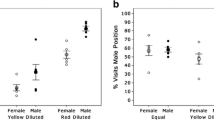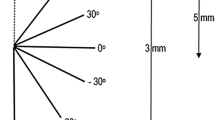Summary
Handling times of hummingbirds (Amazilia rutila and Cynanthus latirostris) visiting artificial flowers were a positive function of corolla length, nectar volume and nectar concentration. Corolla angle had no consistent effects on handling times. A multiple regression model explained 83% of the variation in handling times for these two species. The model also closely fit independent data from another hummingbird, Archilochus colubris, suggesting that it is general enough to apply to other medium-sized, short-billed hummingbird species. When examined across the range of variation normally encountered by hummingbirds in nature, corolla length and nectar volume had the largest effect on nectar extraction rates. At corolla lengths longer than a hummingbird's bill handling time increases markedly. Hummingbirds maximize their net rate of energy intake by selecting flowers with the shortest corolla, the highest nectar concentrations and the highest nectar volume. Since there is a positive relation between bill length and nectar extraction rate, it is surprising that most hummingbirds have relatively short bills.
Similar content being viewed by others
References
Andersson M (1981) On optimal predator search. Theor Popn Biol 19:58–86
Baker HG (1975) Sugar concentrations in nectars from hummingbird flowers. Biotropica 7:37–41
Bolten AB, Feinsinger P, Baker H, Baker I (1979) On the calculation of sugar concentration in flower nectar. Oecologia (Berlin) 41:301–304
Draper NR, Smith H (1981) Applied Regression Analysis, 2nd edition. John Wiley and Sons, New York
Epting RJ (1980) Punctional dependence of the power for hovering flight on wing disc loading in hummingbirds. Physiol Zool 53:347–357
Ewald PW, Williams WA (1982) Function of the bill and tongue in nectar uptake by hummingbirds. Auk 99:573–576
Feinsinger P (1978) Ecological interactions between plants and hummingbirds in a successional tropical community. Ecol Monogr 48:269–287
Feinsinger P (1983) Coevolution and pollination. In: Futuyma DJ, Slatkin M (eds). Coevolution. Sinauer Assoc, Sunderland, Mass., pp 282–310
Gass CL (1978) Experimental studies of foraging in complex laboratory environments. Amer Zool 18:729–738
Grant KA, Grant V (1968) Hummingbirds and their flowers. Columbia Univ. Press, New York
Hainsworth FR (1973) On the tongue of a hummingbird: Its role in the rate and energetics of feeding. Comp Biochem Physiol 46A:65–78
Hainsworth FR, Wolf LL (1972a) Crop volume, nectar concentration and hummingbird energetics. Comp Biochem Physiol 42A:359–366
Hainsworth FR, Wolf LL (1972b) Energetics of nectar extraction in a small, high altitude, tropical hummingbird, Selasphorus flammula. J Comp Physiol 80:377–387
Hainsworth FR, Wolf LL (1976) Nectar characteristics and food selection by hummingbirds. Oecologia (Berlin) 25:101–113
Hainsworth FR, Wolf LL (1979) Feeding: An ecological approach. In: Rosenblatt JS, Hinde RA, Beer, CG, Busnel MC (eds). Advances in the study of behavior. Vol 9. Academic Press, New York, pp 53–96
Harder LD (1983) Flower handling efficiency of bumblebees: morphological aspects of probing time. Oecologia (Berlin) 57:274–280
Heyneman, AF (1983) Optimal sugar concentrations of floral nectars: dependence on sugar intake efficiency and foraging costs. Oecologia (Berlin) 60:198–213
Hilborn R, Stearns SC (1983) On inference in ecology and evolutionary biology: the problem of multiple causes. Acta Biotheoretica 31:145–164
Krebs JR (1978) Optimal foraging: decision rules for predators. In: Krebs JR, Davies NB (eds). Behavioural ecology: An evolutionary approach. Blackwell Scientific, Oxford, pp 23–63
Laverty TM (1980) The flower-visiting behavior of bumble bees: floral complexity and learning. Can J Zool 58:1324–1335
McNair JN (1982) Optimal giving-up times and the marginal value theorem. Am Nat 119:511–529
Montgomerie RD (1979) The energetics of foraging and competition in some Mexican hummingbirds. PhD Thesis, McGill University, Montreal, Quebec
Montgomerie RD, Eadie JM, Harder LD (1984) What do foraging hummingbirds maximize? Oecologia (Berlin) (in press)
Real LA (1977) The kinetics of functional response. Am Nat 111:289–300
Snow DW, Snow BK (1980) Relationships between hummingbirds and flowers in the Andes of Colombia. Bull Br Mus nat Hist (Zool) 38:105–139
Sokal RR, Rohlf FJ (1981) Biometry, 2nd ed. WH Freeman and Co, San Francisco
Stephens DW, Charnov EL (1982) Optimal foraging: some simple stochastic models. Behav Ecol Sociobiol 10:251–263
Stiles FG (1976) Taste preferences, color preferences, and flower choice in hummingbirds. Condor 78:10–26
Stiles FG (1978) Ecological and evolutionary implications of bird pollination. Amer Zool 18:715–727
Stokes RH, Mills R (1965) Viscosity of Electrolytes and Related Properties. Pergamon Press, Oxford
Wolf LL, Hainsworth FR, Stiles FG (1972) Energetics of foraging: rate and efficiency of nectar extraction by hummingbirds. Science 176:1351–1352
Wolf LL, Stiles FG, Hainsworth FR (1976) Ecological organization of a tropical, highland hummingbird community. J Anim Ecol 45:349–379
Author information
Authors and Affiliations
Rights and permissions
About this article
Cite this article
Montgomerie, R.D. Nectar extraction by hummingbirds: response to different floral characters. Oecologia 63, 229–236 (1984). https://doi.org/10.1007/BF00379882
Received:
Issue Date:
DOI: https://doi.org/10.1007/BF00379882




